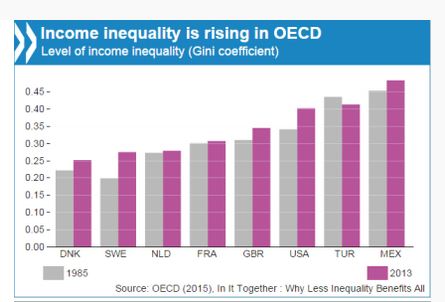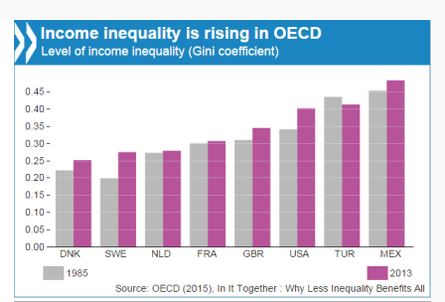 이미지 확대보기
이미지 확대보기반면 소득 하위 40%는 전체 자산의 3%를 소유하는데 그쳤다.
경제협력개발기구(OECD)가 34개 회원국을 대상으로 빈부격차를 조사한 결과다.
기준은 2012년이다.
1980년대 7배, 2000년대 9배보다 차이가 커졌다.
그만큼 소득격차가 더 확대된 것이다.
소득불평등이 가장 심한 나라는 선진국 중에서 단연 미국이었다.
상위와 하위 간의 격차가 무려 19배였다.
OECD는 소득 불평등으로 1990년부터 2010년까지 19개 회원국의 누적 경제 성장률이 4.7% 포인트 낮아졌다고 분석했다.
소득과 자산의 격차가 확대된 주요 원인은 시간제와 임시직, 자영업 종사자의 증가 등에 있다고 OECD는 지적했다.
30세 이하 노동자의 절반가량은 임시직으로 나타났다.
 이미지 확대보기
이미지 확대보기[한국]
한국은 2013년 기준으로 상위 10%가 하위 10%보다 소득이 10.1배 더 많은 것으로 나타났다.
OECD 평균보다 한국의 소득 불평등이 더 심하다.
한국의 노인 빈곤율은 특히 OECD 회원국 중 1위였다.
65세 이상 노인층의 상대적 빈곤율은 49.6%다.
OECD의 평균인 12.6%를 훨씬 초과하는 것이다.
회원국 중 1위다.
[OECD 빈부격차 보도자료 전문]
Income inequality has reached record highs in most OECD countries and remains at even higher levels in many emerging economies. The richest 10 per cent of the population in the OECD now earn 9.6 times the income of the poorest 10 per cent, up from 7:1 in the 1980s and 9:1 in the 2000s, according to a new OECD report.
Why Less Inequality Benefits All also shows that wealth is even more concentrated at the top than income, exacerbating the overall disadvantage of low-income households.
In 2012, the bottom 40% owned only 3% of total household wealth in the 18 OECD countries with comparable data.
By contrast, the top 10% controlled half of all total household wealth and the wealthiest 1% owned 18%.
“We have reached a tipping point. Inequality in OECD countries is at its highest since records began,” said OECD Secretary-General Angel Gurria, launching the report in Paris with Marianne Thyssen, European Commissioner for Employment, Social Affairs, Skills and Labour Mobility. “The evidence shows that high inequality is bad for growth. The case for policy action is as much economic as social. By not addressing inequality, governments are cutting into the social fabric of their countries and hurting their long-term economic growth."
The report highlights the need to address working conditions. The increasing share of people working part-time, on temporary contracts or self-employed is one important driver of growing inequality. Between 1995 and 2013, more than 50 per cent of all jobs created in OECD countries fell into these categories. Low-skilled temporary workers, in particular, have much lower and instable earnings than permanent workers.
Youth are most affected: 40% are in non-standard work and about half of all temporary workers are under 30. They are also less likely to move from a temporary job into a stable permanent one.
Another key lesson from the report is that more needs to be done to reduce the gender gap. The increase in the number of women working has helped stem the rise in inequality, despite their being about 16% less likely to be in paid work and earn about 15% less than men. If the proportion of households with working women had remained at levels of 20 to 25 years ago, income inequality would have increased by almost 1 Gini point more on average.
Beyond its impact on social cohesion, the report stresses that growing inequality and weak opportunities in the labour market are harmful for long-term economic growth. The rise in inequality between 1985 and 2005 in 19 OECD countries analysed is estimated to have knocked 4.7 percentage points off cumulative growth between 1990 and 2010. In fact, it is inequality affecting the bottom 40% which mainly brings down overall growth. As inequality rises, families with lower socio-economic background experience significant falls in educational attainment and skills, implying large amounts of wasted potential and lower social mobility.
Inequality is highest among OECD countries in Chile, Mexico, Turkey, the United States and Israel and lowest in Denmark, Slovenia, Slovak Republic and Norway. Inequality is even higher in major emerging economies although it has fallen in many including Brazil.
To reduce inequality and boost inclusive growth, the OECD says governments should: promote gender equality in employment; broaden access to better jobs; and encourage greater investment in education and skills throughout working life.
Redistribution via taxes and transfers is also an effective way to reduce inequality. In recent decades, the effectiveness of redistribution mechanisms has been weakened in many countries. To address this, policies need to ensure that wealthier individuals, but also multinational firms, pay their share of the tax burden.
김대호 연구소 소장 tiger8280@











































